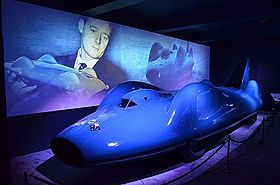Bluebird-Proteus CN7
| Bluebird-Proteus CN7 | |
|---|---|

Bluebird today at Beaulieu
|
|
| Overview | |
| Manufacturer | Motor Panels Ltd. |
| Also called | Proteus-Bluebird Campbell–Norris 7 |
| Production | 1 |
| Designer | Ken Norris |
| Body and chassis | |
| Body style | streamlined fully enclosed "turtle shell" |
| Layout | four-wheel drive centre engined |
| Powertrain | |
| Engine | A Bristol-Siddeley Proteus 705 free-turbine turboshaft) engine of 4,450 shp (3,320 kW) |
| Transmission | Front and rear drives to separate 3.6 to 1 spiral bevel gearboxes |
| Dimensions | |
| Wheelbase | 13 ft 6 in (4.11 m) |
| Length | 30 ft (9.1 m) |
| Width | 5 ft 6 in (1.68 m) Track front and rear |
| Height | 4 ft 9 in (1.45 m) without the vertical fin, 7 ft 8 in (2.34 m) with fin |
| Kerb weight | 8,064 lb (3,657.77 kg) – 8,960 lb (4,064.19 kg) |
The Bluebird-Proteus CN7 is a gas turbine-powered vehicle that was driven by Donald Campbell and achieved the world land speed record on Lake Eyre in Australia on July 17, 1964. The vehicle set the FIA world record for the flying mile at 403.10 mph (648.73 km/h).
In 1956, Campbell began planning a car to break the land speed record, which then stood at 394 mph (630 km/h) set by John Cobb in the Railton Mobil Special. The Norris brothers, who had designed Campbell's highly successful Bluebird K7 hydroplane, designed Bluebird-Proteus CN7 with 500 mph (800 km/h) in mind. The CN7 (Campbell–Norris 7) was constructed by Motor Panels Ltd in Coventry, supervised by James Milner Phillips with Ken Norris as chief designer and was completed by the spring of 1960.
Bluebird CN7 was the first land speed record vehicle to be powered by a gas turbine engine. The Bristol-Siddeley Proteus was the Bristol Aeroplane Company's first successful gas turbine engine design, and delivered 4,450 shp (3,320 kW) plus approximately 1,000 lbf (4,400 N) of exhaust thrust. The Proteus was a two spool, reverse flow turboshaft. Because the turbine stages of the inner spool drove no compressor stages, but only a power shaft, this engine is sometimes classified as a free turbine. The engine, a Proteus 705, was specially modified by Bristol's Stanley Hooker to have a power shaft at each end of the engine. These shafts are connected directly to final drive assemblies with differentials and fixed ratios of 3.6 to 1 providing power to all four wheels via half-shafts.
...
Wikipedia
